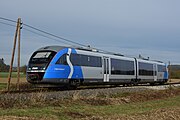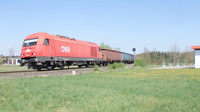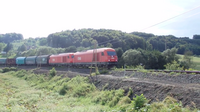Thermenbahn
| Fehring – Fürstenfeld – Friedberg | |||||||||||||||||||||||||||||||||||||||||||||||||||||||||||||||||||||||||||||||||||||||||||||||||||||||||||||||||||||||||||||||||||||||||||||||||||||
|---|---|---|---|---|---|---|---|---|---|---|---|---|---|---|---|---|---|---|---|---|---|---|---|---|---|---|---|---|---|---|---|---|---|---|---|---|---|---|---|---|---|---|---|---|---|---|---|---|---|---|---|---|---|---|---|---|---|---|---|---|---|---|---|---|---|---|---|---|---|---|---|---|---|---|---|---|---|---|---|---|---|---|---|---|---|---|---|---|---|---|---|---|---|---|---|---|---|---|---|---|---|---|---|---|---|---|---|---|---|---|---|---|---|---|---|---|---|---|---|---|---|---|---|---|---|---|---|---|---|---|---|---|---|---|---|---|---|---|---|---|---|---|---|---|---|---|---|---|---|
| Course book route (ÖBB) : | 520 | ||||||||||||||||||||||||||||||||||||||||||||||||||||||||||||||||||||||||||||||||||||||||||||||||||||||||||||||||||||||||||||||||||||||||||||||||||||
| Route length: | 77 km | ||||||||||||||||||||||||||||||||||||||||||||||||||||||||||||||||||||||||||||||||||||||||||||||||||||||||||||||||||||||||||||||||||||||||||||||||||||
| Gauge : | 1435 mm ( standard gauge ) | ||||||||||||||||||||||||||||||||||||||||||||||||||||||||||||||||||||||||||||||||||||||||||||||||||||||||||||||||||||||||||||||||||||||||||||||||||||
| Minimum radius : | 118 m | ||||||||||||||||||||||||||||||||||||||||||||||||||||||||||||||||||||||||||||||||||||||||||||||||||||||||||||||||||||||||||||||||||||||||||||||||||||
| Top speed: | 80 km / h | ||||||||||||||||||||||||||||||||||||||||||||||||||||||||||||||||||||||||||||||||||||||||||||||||||||||||||||||||||||||||||||||||||||||||||||||||||||
|
|||||||||||||||||||||||||||||||||||||||||||||||||||||||||||||||||||||||||||||||||||||||||||||||||||||||||||||||||||||||||||||||||||||||||||||||||||||
The Thermenbahn is a railway line operated by the ÖBB in Styria and runs through the Eastern Styrian hill country . In Friedberg it connects to the Wechselbahn and the Pinkatalbahn and leads via Hartberg and Fürstenfeld to Fehring , where it meets the Styrian Ostbahn .
Surname
The name under which the railway line is marketed today is derived from the numerous thermal baths in Eastern Styria that the railway runs past. These are located in Sebersdorf , Bad Waltersdorf , Bad Blumau and Bad Loipersdorf .
Freight transport
A sliding wall wagon train, consisting of 35 to 40 two-axle Hbis-tt freight wagons and the four-axle Habbins (the latter were decimated until the train stopped ), ran once a day in each direction from Albersdorf near Gleisdorf via Vienna and Marchegg to Bratislava . Car parts were transported for the “Magna” plant in Bratislava. However, after many years, the train became a demand train in 2017, as the delivery to Bratislava was almost stopped. Since then, the train has not run a single time (as of December 19, 2019).
A pair of service trains runs between Fehring and Fürstenfeld on Mondays, Wednesdays and Fridays, which, among other things, supplies and removes steel, wire, wood, gravel and scrap from the connecting railways, but also from the train station in Fürstenfeld. In a northerly direction, wagons are only provided again from Rohrbach-Vorau. The loading of wood is of particular importance here. Only from Friedberg is there regular freight train traffic in the direction of Vienna due to the freight from Oberwart.
passenger traffic
When the ÖBB 2043 and ÖBB 2143 locomotives and the Schlieren wagons used throughout Austria disappeared from the Thermenbahn around 2010 , only locomotives of the 2016 series , City Shuttle wagons and railcars of the 5022 series were to be found from now on .
The direct trains Vienna - Wiener Neustadt - Friedberg - Fürstenfeld - Fehring (- Graz ) were less and less and in 2014 they were completely stopped with the exception of one pair of trains on Sundays and public holidays (REX 2741 Vienna Meidling - Fehring, REX 2772 Fehring - Vienna Hbf). Since then, apart from this pair of trains, on which a CityShuttle push-pull train was used, only Siemens railcars of the 5022 series have been used. For the first time with the timetable change on December 15, 2019, a second train was extended to Vienna. This runs in the morning as REX 2717 from Wiener Neustadt to Fehring and then as REX 2756 from Fehring to Vienna Hbf. A CityShuttle shuttle train is used on this circuit, which only runs on Saturdays and Sundays. Since then, a pair of trains have been on the Thermenbahn on Saturdays and two pairs of trains on Sundays, on which push-pull trains are used again and enable a direct connection to Vienna.
In 2019, the state of Styria announced that the line would have to be renovated by the ÖBB in order for passenger traffic to continue beyond 2028. Measures required by the state are improvements in train stations and in the line layout as well as the abandonment or securing of the 80 unbarred level crossings, which from 2029 may only be used at 20 km / h. This announcement was followed by protests from the population and parts of the population, which, among other things, expressed themselves in a petition.
history
The railway line was put into operation in four sections. The first section was the Fehring – Fürstenfeld local railway, which began operating on October 1, 1885. On October 19, 1891, it was extended to Hartberg and the Bierbaum – Neudau local railway was also opened as a branching line. The gap to Friedberg was closed on October 15, 1905.
Local railway Fehring – Fürstenfeld
Eastern Styria has long been one of the forgotten regions in terms of traffic development. The Southern Railway was completed as early as 1854, and other railway lines were soon built in the country. But Eastern Styria was excluded for the time being. Fürstenfeld wanted the Graz-Raaber Railway to run from Gleisdorf via Ilz to St. Gotthard and was supported by Hartberg. The inspection by a commission took place at the end of November 1868, but as a result of objections by the Feldbachers, the Hungarian Western Railway was built through the Raab Valley and opened in its total length on May 1, 1873.
During this time, the Wimpffen-Schwarz consortium presented the Vienna-Wiener Neustadt-Hartberg-Fürstenfeld-Gleichenberg-Bad Radkersburg-Pettau-Agram railway project to the government, which received the pre-concession. With the adoption of the law on the so-called Vienna – Novi Railway on May 17, 1873, nothing seemed to stand in the way of fulfilling the wishes of the East Styrians, but the project collapsed as a result of the " Great Crash ".
It is thanks to the long-term efforts of interested parties that the Fehring – Fürstenfeld section of the railway came about, was granted the concession in 1884 and opened on October 1, 1885.
The Fürstenfeld – Hartberg railway construction
As early as April 1885, the route to Hartberg was inspected with a branch from Bierbaum to Neudau. The latter was intended as a horse-drawn tram. The extension of the railway was particularly demanded by the Agricultural Society, from which the Vorau branch was particularly pressing, since the nearest railway station is almost ten hours away and almost all other areas of the country are traversed by a railway. After long efforts, the concessionaires Josef Ressavar, Dr. Leopold Link and Josef Sutter in connection with the construction companies Lukrits and Rzizek to secure a number of contributions from interested parties, primarily from the state and the government.
The district and community representatives of Hartberg voted for the creation of this railway a sum of 85,000 guilders, namely 65,000 guilders in common shares and 20,000 guilders in priority shares. In addition, the Styrian Landtag approved an amount of 200,000 guilders in its session on January 12, 1886 for the construction of the standard gauge Fürstenfeld – Hartberg railway through the Safental. The investment capital was 1,846,000 guilders, divided into 9,230 shares with a nominal value of 200 guilders each, and consisted of 3,290 1st category priority shares, 3,750 2nd category priority shares and 2,190 ordinary shares, 1,250 of which were from the state and the remaining shares were denominated Districts and cities Hartberg and Fürstenfeld and were taken over by the other interested parties. the effective construction costs including intercalar interest, reserve funds and the cost of escompting the state contribution, which only became liquid in five annual installments, amounted to 1,813,000 guilders.
On July 22, 1890, the license was finally granted in favor of Ressavar, Sutter and Dr. Link issued for the standard gauge local train from Fürstenfeld to Hartberg with a branch from Bierbaum via Burgau to Neudau . Construction was the company Lukrits, Rzizek and Union-building company transferred who completed it within a year. From October 21 to the end of October 1890, the railway line was politically inspected. Work up to Sebersdorf was completed by late autumn 1890 . Construction was only started after this inspection. The severe and long winter significantly hampered construction progress in the first few months of the year. In the spring of 1891 the work was continued - and completed earlier than planned. In the second half of July 1891 the first hoisting machines came to Hartberg.
In the meantime, the issue of shares by the entrepreneurs or concessionaires has also been approved by the competent authorities, so that the financial side of the company was also clarified. On October 10, 1891, the rehearsals and revisions of the building took place, so that from October 19, 1891 the “forgotten lands” were finally connected to the world.
Local railway Hartberg – Friedberg
As early as 1891, engineers were concerned with the layout of the railway line from Hartberg via Friedberg and the change to Aspang. The Hartberg MP Hagenhofer was involved in numerous speeches and motions for the construction of the alternate track. But it would take years before the project could be carried out.
In 1901 the emperor sanctioned the bill for the construction of the line. The Hartberger kk Oberbaurat Ferdinand Leiß was entrusted with the construction management .
Construction began on October 10, 1903. The ceremonial opening with the first passenger train took place on October 15, 1905. The cost for the construction was 4,040,000 crowns.
100 year celebration
A special train traveled the route from Vienna Südbahnhof via Aspang to Hartberg and back, with 600 participants on the train. The train consisted of a 52.4984 + 17c372 + ten two-axle green frame wagons, a two-axle wine tavern car and a four-axle buffet car. Ceremonies were celebrated at all adjacent train stations. A total of around 5,000 visitors attended the celebrations.
Driving resources
The locomotives of the diesel traction were initially locomotives of the 2043 series , which were replaced by locomotives of the 2016 series ("Hercules"). City shuttle sets are used as the vehicle material . The class 5047 railcars initially used were replaced by class 5022 ("Desiro classic") railcars , which are also used as a double set.
Image gallery
A mixed freight train hauled by an ÖBB 2016 near Söchau
literature
- Peter Wegenstein, Hellmuth Fröhlich (photo): “The route over the change. This volume deals with the routes Wiener Neustadt – Fehring, Bierbaum – Neudau, Friedberg – state border next Rechnitz and Oberwart – Oberschützen ”. First edition, Bahn im Bild, Volume 77, ZDB -ID 52827-4 , Pospischil, Vienna 1991.
- Alfred Horn: "ÖBB Handbook 1993". ÖBB-Handbuch, Volume 1993.1993, ZDB -ID 644323-0 , Bohmann, Vienna 1993, ISBN 3-7002-0824-3 .
Individual evidence
- ^ Petition to maintain the thermal baths . Retrieved December 14, 2019.
- ↑ a b Volkswirthschaftliche Zeitung. (...) Local train Fürstenfeld-Hartberg. In: Das Vaterland , No. 285/1891 (XXXII. Year), October 17, 1891, p. 6, top right. (Online at ANNO ). .
- ↑ a b The opening of the railway Friedberg-Hartenberg. In: Neue Freie Presse , Abendblatt, No. 14781/1905, October 16, 1905, p. 11, center right. (Online at ANNO ). .
- ^ "Ordinance sheet for the Imperial and Royal Army. Normal Ordinances ", Volume 15.1873, ZDB -ID 1487809-4 , Austria-Hungary, Vienna 1873, p. 228.
- ↑ RGBl. 1884/133 .
- ^ Telegrams from the Telegraph Correspondence Bureau. Fürstenfeld. In: Wiener Zeitung , No. 225/1885, October 2, 1885, p. 6 middle. (Online at ANNO ). .
- ↑ RGBl 1890/163 .
- ↑ RGBl. 1901/150 .









